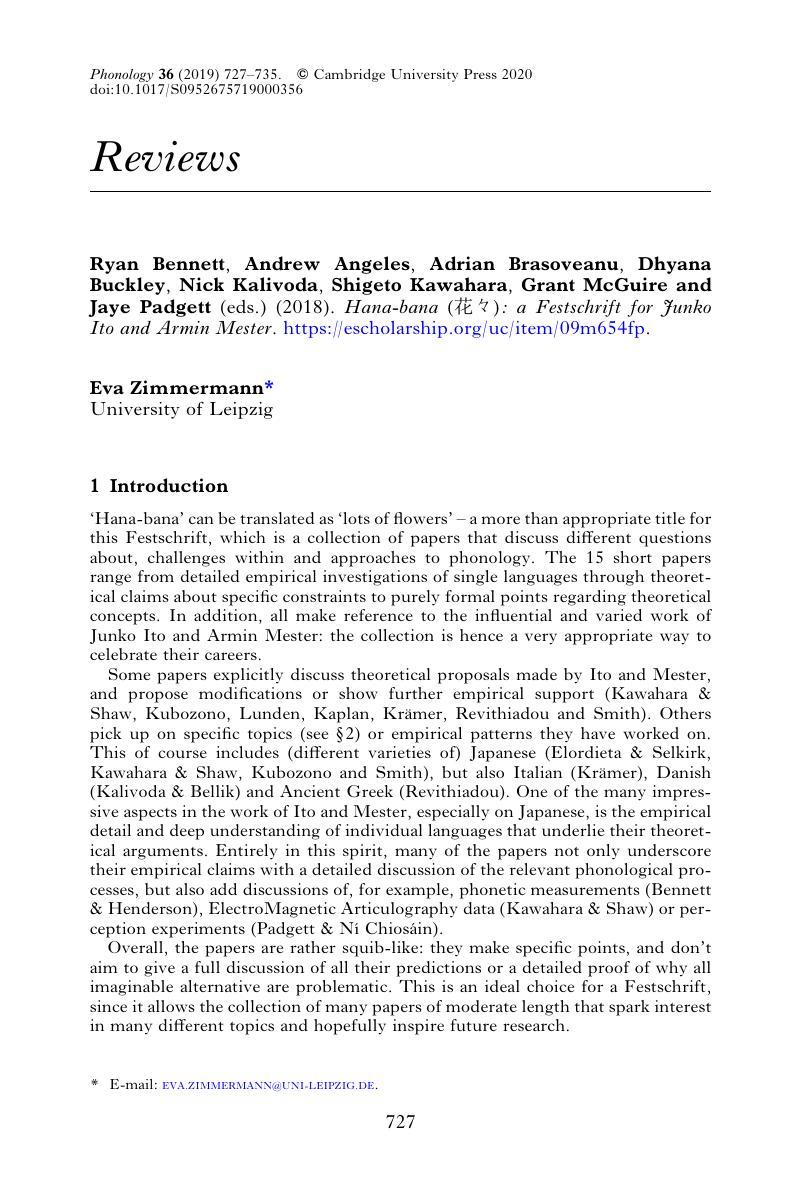No CrossRef data available.
Article contents
Ryan Bennett, Andrew Angeles, Adrian Brasoveanu, Dhyana Buckley, Nick Kalivoda, Shigeto Kawahara, Grant McGuire andJaye Padgett (eds.) (2018). Hana-bana (花々): a Festschrift for Junko Ito and Armin Mester. https://escholarship.org/uc/item/09m654fp.
Review products
Ryan Bennett, Andrew Angeles, Adrian Brasoveanu, Dhyana Buckley, Nick Kalivoda, Shigeto Kawahara, Grant McGuire andJaye Padgett (eds.) (2018). Hana-bana (花々): a Festschrift for Junko Ito and Armin Mester. https://escholarship.org/uc/item/09m654fp.
Published online by Cambridge University Press: 20 January 2020
Abstract
An abstract is not available for this content so a preview has been provided. Please use the Get access link above for information on how to access this content.

- Type
- Reviews
- Information
- Copyright
- Copyright © Cambridge University Press 2020
Footnotes
*
E-mail: [email protected].
References
REFERENCES
Alber, Birgit (2010). An exploration of truncation in Italian. Rutgers Working Papers in Linguistics 3. 1–30.Google Scholar
Baković, Eric (2007). A revised typology of opaque generalisations. Phonology 24. 217–259.CrossRefGoogle Scholar
Bateman, Leah, O'Keefe, Michael, Reilly, Ehren & Werle, Adam (eds.) (2007). Papers in Optimality Theory III. Amherst: GLSA.Google Scholar
Harley, Heidi & Noyer, Rolf (1999). Distributed Morphology. Glot International 4:4. 3–9.Google Scholar
Ito, Junko & Mester, Armin (1995a). The core-periphery structure of the lexicon and constraints on reranking. In Beckman, Jill N., Dickey, Laura Walsh & Urbanczyk, Suzanne (eds.) Papers in Optimality Theory. Amherst: GLSA. 181–209.Google Scholar
Ito, Junko & Mester, Armin (1995b). Japanese phonology. In Goldsmith, John A. (ed.) The handbook of phonological theory. Cambridge, Mass. & Oxford: Blackwell. 817–838.Google Scholar
Ito, Junko & Mester, Armin (1999a). The phonological lexicon. In Tsujimura, Natsuko (ed.) The handbook of Japanese linguistics. Malden, Mass. & Oxford: Blackwell. 62–100.Google Scholar
Ito, Junko & Mester, Armin (1999b). Realignment. In Kager, René, van der Hulst, Harry & Zonneveld, Wim (eds.) The prosody–morphology interface. Cambridge: Cambridge University Press. 188–217.CrossRefGoogle Scholar
Ito, Junko & Mester, Armin (2008). Lexical classes in phonology. In Miyagawa, Shigeru & Saito, Mamoru (eds.) The Oxford handbook of Japanese linguistics. Oxford & New York: Oxford University Press. 84–106.Google Scholar
Ito, Junko & Mester, Armin (2015a). The perfect prosodic word in Danish. Nordic Journal of Linguistics 38. 5–36.Google Scholar
Ito, Junko & Mester, Armin (2015b). Sino-Japanese phonology. In Kubozono, Haruo (ed.) The handbook of Japanese phonetics and phonology. Berlin: de Gruyter Mouton. 289–312.Google Scholar
Ito, Junko & Mester, Armin (2016a). Ancient Greek accent: anti-lapse and tonal antepenultimacy. Ms, University of California, Santa Cruz.Google Scholar
Kiparsky, Paul (1973). Abstractness, opacity, and global rules. In Fujimura, Osamu (ed.) Three dimensions in linguistic theory. Tokyo: TEC. 57–86.Google Scholar
Pater, Joe (2007). The locus of exceptionality: morpheme-specific phonology as constraint indexation. In Bateman et al. (2007). 259–296.Google Scholar
Rosen, Eric (2016). Predicting the unpredictable: capturing the apparent semi-regularity of rendaku voicing in Japanese through Harmonic Grammar. BLS 42. 235–249.Google Scholar
Samek-Lodovici, Vieri (1994). A unified analysis of crosslinguistic morphological gemination. In Ackema, Peter & Schoorlemmer, Maaike (eds.) ConSole I proceedings. The Hague: Holland Academic Graphics. 265–283.Google Scholar
Shaw, Jason A. & Kawahara, Shigeto (2018). Consequences of high vowel deletion for syllabification in Japanese. In Gillian Gallagher, Maria Gouskova & Sora Heng Yin (eds.) Proceedings of the 2017 Annual Meeting on Phonology. http://dx.doi.org/10.3765/amp.v5i0.4241.CrossRefGoogle Scholar
Smolensky, Paul & Goldrick, Matthew (2016). Gradient symbolic representations in grammar: the case of French liaison. Ms, Johns Hopkins University & Northwestern University. Available as ROA-1286 from the Rutgers Optimality Archive.Google Scholar
Trommer, Jochen (2019). A harmonic layer account of Levantine Arabic syncope. Paper presented at the 16th Old World Conference in Phonology, Verona. Available (August 2019) at https://home.uni-leipzig.de/jtrommer/papers/LevantineOCPVerona2019.pdf.Google Scholar
Walker, Rachel (2019). Gradient feature activation and the special status of coronals. Paper presented at the Princeton Phonology Forum (PφF 2019).Google Scholar
Wolf, Matthew (2007). For an autosegmental theory of mutation. In Bateman et al. (2007). 315–404.Google Scholar
Zimmermann, Eva (2018). Being exceptional is being weak: tonal exceptions in San Miguel el Grande Mixtec. In Gillian Gallagher, Maria Gouskova & Sora Heng Yin (eds.) Supplemental proceedings of the 2017 Annual Meeting on Phonology. http://dx.doi.org/10.3765/amp.v5i0.4240.Google Scholar
Zimmermann, Eva (2019). Gradient symbolic representations and the typology of ghost segments. In Katherine Hout, Anna Mai, Adam McCollum, Sharon Rose & Matt Zaslansky (eds.) Supplemental proceedings of the 2018 Annual Meeting on Phonology. http://dx.doi.org/10.3765/amp.v7i0.4576.Google Scholar


